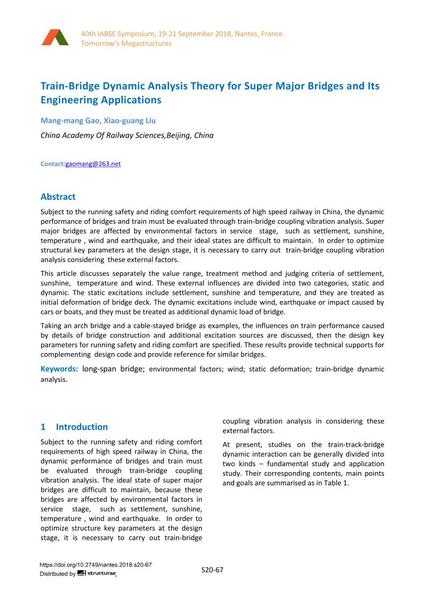Train-Bridge Dynamic Analysis Theory for Super Major Bridges and Its Engineering Applications

|
|
|||||||||||
Bibliografische Angaben
| Autor(en): |
Mang-mang Gao
(China Academy Of Railway Sciences,Beijing, China)
Xiao-guang Liu (China Academy Of Railway Sciences,Beijing, China) |
||||
|---|---|---|---|---|---|
| Medium: | Tagungsbeitrag | ||||
| Sprache(n): | Englisch | ||||
| Tagung: | IABSE Symposium: Tomorrow’s Megastructures, Nantes, France, 19-21 September 2018 | ||||
| Veröffentlicht in: | IABSE Symposium Nantes 2018 | ||||
|
|||||
| Seite(n): | S20-67 | ||||
| Anzahl der Seiten (im PDF): | 7 | ||||
| DOI: | 10.2749/nantes.2018.s20-67 | ||||
| Abstrakt: |
Subject to the running safety and riding comfort requirements of high speed railway in China, the dynamic performance of bridges and train must be evaluated through train-bridge coupling vibration analysis. Super major bridges are affected by environmental factors in service stage, such as settlement, sunshine, temperature, wind and earthquake, and their ideal states are difficult to maintain. In order to optimize structural key parameters at the design stage, it is necessary to carry out train-bridge coupling vibration analysis considering these external factors. This article discusses separately the value range, treatment method and judging criteria of settlement, sunshine, temperature and wind. These external influences are divided into two categories, static and dynamic. The static excitations include settlement, sunshine and temperature, and they are treated as initial deformation of bridge deck. The dynamic excitations include wind, earthquake or impact caused by cars or boats, and they must be treated as additional dynamic load of bridge. Taking an arch bridge and a cable-stayed bridge as examples, the influences on train performance caused by details of bridge construction and additional excitation sources are discussed, then the design key parameters for running safety and riding comfort are specified. These results provide technical supports for complementing design code and provide reference for similar bridges. |
||||
| Stichwörter: |
Wind
|
||||
